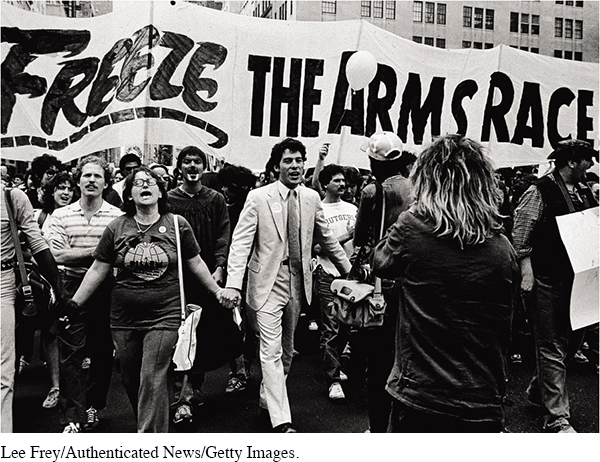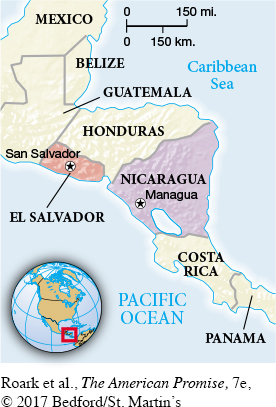The American Promise: Printed Page 886
The American Promise, Value Edition: Printed Page 801
The American Promise: A Concise History: Printed Page 916
Militarization and Interventions Abroad
Reagan expanded the military with new bombers and missiles, an enhanced nuclear force in Europe, a larger navy, and a rapid-
Reagan justified the military buildup as a means to negotiate with the Soviets from a position of strength, but he provoked an outburst of pleas to halt the arms race. In 1982, 750,000 people marched in New York City, demanding a freeze on additional nuclear weapons. That same year the National Conference of Catholic Bishops issued a strong call for nuclear disarmament. Hundreds of thousands demonstrated across Europe, stimulated by fears of new U.S. missiles scheduled for deployment there in 1983.

The U.S. military buildup was powerless before the growing threat of terrorism by nonstate organizations seeking to gain political objectives by attacking civilian populations. Terrorism had a long history throughout the world, but in the 1970s and 1980s Americans saw it escalate among groups hostile to Israel and Western policies. In 1972, for example, after the Israeli occupation of the West Bank, Palestinian terrorists murdered eleven Israeli athletes at the Munich Olympics. The terrorist organization Hezbollah, composed of Shiite Muslims and backed by Iran and Syria, arose in Lebanon in 1982 after Israeli forces invaded that country to stop the Palestine Liberation Organization from using sanctuaries in Lebanon to launch attacks on Israel.
The American Promise: Printed Page 886
The American Promise, Value Edition: Printed Page 801
The American Promise: A Concise History: Printed Page 916
Page 887Reagan’s effort to stabilize Lebanon by sending 2,000 Marines to join an international peacekeeping mission failed. In April 1983, a suicide attack on the U.S. Embassy in Beirut killed 63 people, and in October a Hezbollah fighter drove a bomb-

Following a Cold War pattern begun under Dwight D. Eisenhower, the Reagan administration sought to contain leftist movements across the globe. In October 1983, 5,000 U.S. troops invaded Grenada, a small Caribbean nation where Marxists had staged a successful coup. In Asia, the United States covertly aided the Afghan rebels’ war against Afghanistan’s Soviet-
Administration officials were most fearful of left-